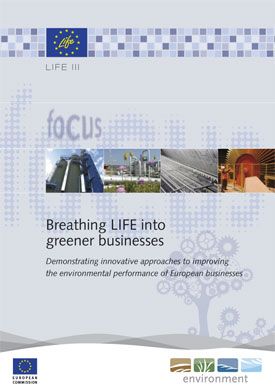 EU-bidraget LIFE+ väntas utlysas inom de närmaste dagarna. Det stöder innovativa miljölösningar och genomförandet av Natura 2000. Naturvårdsverket har redan haft en skrivarstuga för de som planerar LIFE+ naturansökningar. Jag var med och våra svenska experter gav mycket god handledning. Kolla länkar till EU-Kommissionens sida för LIFE+ nedan och till anmälan för Kommissionens informationsmöte 8/3 i Stockholm.
EU-bidraget LIFE+ väntas utlysas inom de närmaste dagarna. Det stöder innovativa miljölösningar och genomförandet av Natura 2000. Naturvårdsverket har redan haft en skrivarstuga för de som planerar LIFE+ naturansökningar. Jag var med och våra svenska experter gav mycket god handledning. Kolla länkar till EU-Kommissionens sida för LIFE+ nedan och till anmälan för Kommissionens informationsmöte 8/3 i Stockholm.
I dag avslutas också EU-Kommissionens konsultation om det kommande LIFE+. Jag har skrivit in några av mina kommnetarer till detta längst ner i inlägget.

Ur EU-Kommissionens inbjudan till informationsmöte
Utlysningen gäller 265,360 miljoner Euro för samfinansiering av projekt över hela EU inom tre huvudområden: natur och biologisk mångfald, miljöpolitik och överordnad styrning (governance) samt information och kommunikation. I miljöpolitik och överordnad styrning (governance) ingår innovativa miljölösningar. Därför väljer jag att illustrera med en bild av EU-Kommissionens rapport om LIFE-miljöbusiness projekt. Klicka här för mer information!
EU Kommissionens Informationsmöte om LIFE+ Programmet blir den 7 march 2011 i Europahuset, Regeringsgatan 65 i Stockholm. Mötet skall i första hand hjälpa intresserade avgöra om man vill ansöka eller ej. Det ska också informera så att de som söker kan undvika de vanligaste misstagen. Det projketexemple som ska presenteras är ett LIFE+Natur-projekt. Det känns inte bra, då svenska organisationer genom Naturvårdsverket har god kännedom om dessa projket, medan det är aningen förvånande med utfallet av LIFE+ miljöprojekt.
Här är länk till EU-Kommissionens konsulters information om detta möte och möjlighet att anmäla sig: http://stellaconsulting.com/LIFE+/ECInvitationSweden2011.pdf
Länk till EU-Kommissionens sida för LIFE+: http://ec.europa.eu/environment/life/
Mina kommentarer till Consultation on the future of LIFE+ :
”Support innovative SME:s in the stages of development that do not include research but are prisor to market penetration. The current programme has such an bias towards supporting public organisations that it is counterproductive since the resources available for environmental innovation aside from research are so limited. Since the need for development of eco innovations is tremendous, I also propose that the Programme focusses on such innovations. Countries have already agreed to implement the Natura 200 network. To the extent EU-funding is needed to help countries fulfil their obligations it should be provided through rural development programmes.”
Why LIFE funds must increase considerably:
” The environmental problems ar huge. The global distribution of income makes it imperative to solve these problems mostly through innovations. The EU-citizens will not accept to decrease their standard of livning to that of the average citizen on the globe. But people in poor coutries will not accept to halt their increase of standard of living at a level that would be sustainable to the earth unless EU citizens arrive at a similar level of consumption of the limited resources available. Environmental innovations is the only way to solve this conflict. Research is not innovations, nor do innovations mostly stem from reserach. The research funds are likely to remain very complicated to work with. The Eco Innovation initiative is far too small and it covers a situations much closer to the market.”
Specifying needs to develop LIFE+
”Grants are needed for financing environmental innovations that do not fit under the reserach programmes. These mostly include demands for at least three participating coutnries which make the really difficult to work with effectively for micro-companies. There is major problem that needs a solution, and that is how to support very small companies that are built around an eco innovative idea. Support for activities of venture capitalists does not help to solve this problem. Such organisations are per definition too short-sighted to help innovations over the ”valley of death””
”A specification is needed to our reply to question fourteen. We state that more tha 50 % of eligible costs sholud be supported for some private bodies. Certainly not for every private body. Those in dire need for higher support are the microcompanies that are basically created around an environmental innovation. We propose that developmnet for such innovations should receive up to 75 % support.”


Senaste Kommentarer.